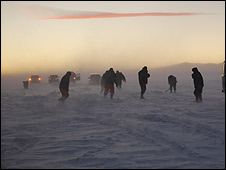GOLDMAN PRIZEWINNER SHOOTS UP FOREIGN MINING FIRMS IN MONGOLIA
WESTERN DECEPTIONS AND THE EXTINCTION OF THE NOMADS

Predatory capitalism has invaded Mongolia — the savage western hordes overrunning the land — and but for the recent Hollywood movie spectacle Mongol [1] and colorful travel magazine articles no one in America hears much of anything about the place. Behind the bells and whistles promoting ‘democracy’, ‘conservation’, ‘human rights’, and a ‘free press’, Mongolia is under attack and the people suffering a world of hurt. The same companies destroying Mongolia are destroying Congo and Canada and everywhere else they appear. Meanwhile, three years after winning the Goldman Environmental Prize — the ‘Green Nobel’ — Mongol herder Tsetsegee Munkhbayar shot at foreign mining operations and thus he is denounced and shunned by the same foreigners who recognized him as a hero. This is a story about the killing of the earth, the killing of truth, the killing of hope — and the killing of the nomad’s way.
In early September 2010, a small band of Mongolian citizens armed with hunting rifles opened fire on gold mining equipment owned by two foreign mining firms operating illegally in northern Mongolia. One of the four armed activists was Tsetsegee Munkhbayar, a 2007 winner of the prestigious Goldman Environmental Prize — the ‘Green Nobel’ — awarded annually to pivotal environmentalists taking a stand around the globe.
“With unwavering passion,” reads the National Geographic Emerging Explorers profile of Tsetsegee Munkhbayar, “he inspired thousands of local villagers, held press conferences, organized town hall meetings, lobbied legislators, and led protest marches — mobilizing an unprecedented level of grassroots participation among citizens who previously felt they had no power to shape government policy.” [2]
Three years after winning the award — and a whole lot more illegal mining and pollution later — Munkhbayar’s little gang of four and their militant actions against the capitalist invasion remain in complete media whiteout in the western press: it’s as if the early September shootings never happened. While the civic activists face possible prosecution and extended jail terms — if not sudden unexplained death — rapacious mining companies further plunder and pollute the land.
The gang of four — Tsetsegee Munkhbayar, G. Bayaraa, D. Tumurbaatar and O. Sambuu-Yondon — are environmentalists from the United Movement of Mongolian Rivers and Lakes (UMMRL), a consortium of Mongolian groups organized to fight foreign extractive industries that have invaded the fledgling ‘democracy’. UMMRL was formed in June 4, 2009 after its predecessor, the Mongolian Nature Protection Coalition (MNPC), dissolved in the spring of 2008. Tsetsegee Munkhbayar — and many collaborators he works with — was pivotal to the creation of both MNPC and UMMRL.

Behind the story of Tsetsegee Munkhbayar is a story of greed, private profit, deception, betrayal, stealth and heartbreak. Just three years after becoming a global hero, Tsetsegee Munkhbayar is today shunned by the people who lobbied to make him a Goldman Award winner, and they have even branded him and his colleagues as terrorists.
“The shooters sent a powerful message,” reported EurasiaNet, the only foreign media outlet to report on the recent shooting action. “Puraam, a Chinese firm, and Centerra Gold, a Canadian-operated company, “aren’t welcome in the area, one of Mongolia’s only forested regions.” [3] Centerra is also operating in Kyrgyzstan, a former Russian republic where paramilitary government forces repressed public protests and shot hundreds of unarmed protesters in 2010. [4]
Centerra Gold and Puraam Mining are operating on 168 hectares of land and contaminating the headwaters of the Selenge, Mongolia’s largest river, and the source for Lake Baikal, the world’s largest freshwater lake. The Gatsuur deposit, currently exploited by Centerra Gold, contains an estimated 1.3 million ounces of gold valued at tens of billions of dollars. Centerra’s Boroo gold mine began production in 2004 and yields an average of 180,000 ounces of gold annually.
The locals see very little from the gold taken from their lands. At least 70% of the population lives in absolute poverty. Alcoholism is a national epidemic. The social fabric is unraveling. Human trafficking is a big business. Everything is for sale, or already sold.
“[People] see the 1990s privatization rush and years of harsh weather as a kind of economic one-two punch. Twenty years after Mongolia peacefully threw off 70 years of communism, one-third of Mongolia’s 2.9 million people live below the poverty level of less than $2 a day; even white-collar workers like doctors and teachers can earn as little as $300 a month.” [5]

Mining operations devastate the sensitive Mongolian environment. Photo credit: unknown.
The mining companies arrived in Mongolia hand-in-hand with the international NGOs — euphemistically called ‘non-government’ organizations — and they promote the western imposed ideal of ‘privatization’. The unstated assumptions that came along with this are that freedom-loving westerners are uniquely qualified to teach Mongolians about democracy, human rights, good government and environmental stewardship. Tsetsegee Munkhbayar was patronized and promoted by this framework of foreign intervention.
“According to the promoters,” writes Dr. Joan Roelofs, “the precondition for such benefits is a ‘free market’ economy, or the adoption of ‘neoliberalism’, which entails the privatization of most government functions, deregulation of business, abolition of subsidies and welfare, and availability of all assets (land, TV stations, national newspapers, etc.) for purchase by any corporation, regardless of nationality. Freedom also means that foreigners can start any business anywhere…” [6]
Read moreThe Exploitation and Destruction of Mongolia




